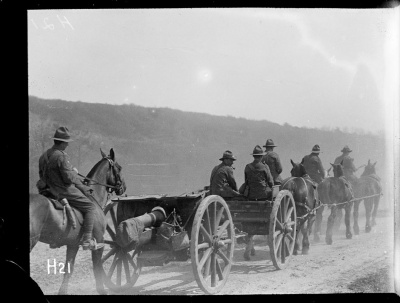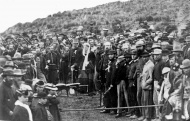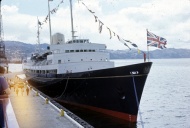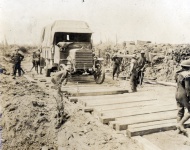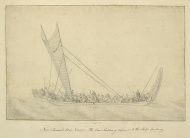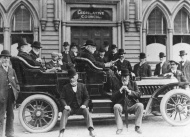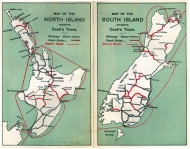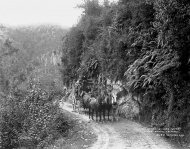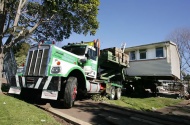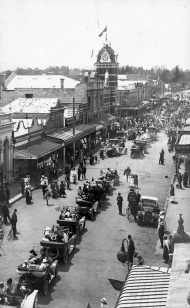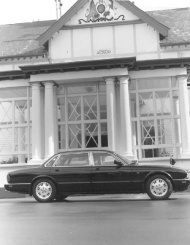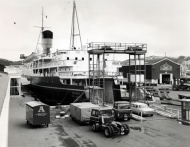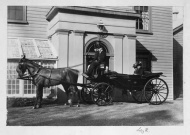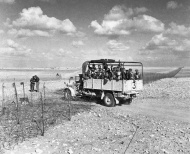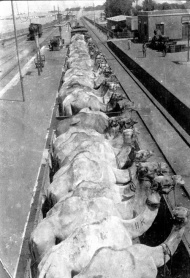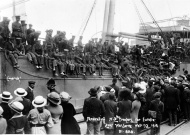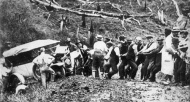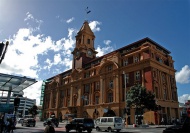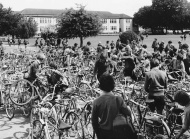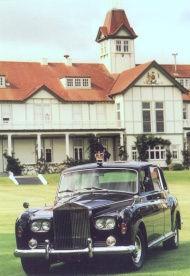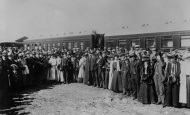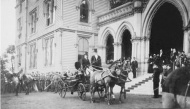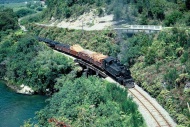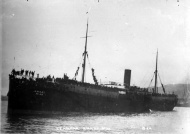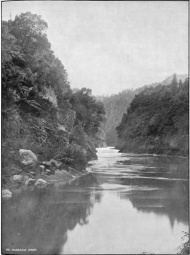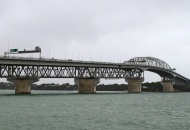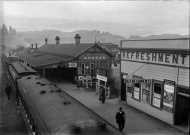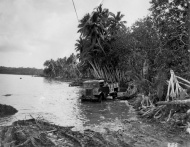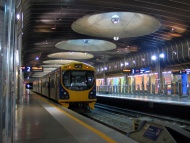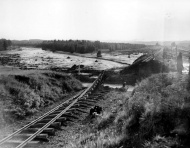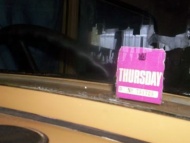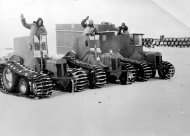Events In History
-
 30 July 1979Carless days introduced
30 July 1979Carless days introducedCarless days for motor vehicles were introduced to combat the second ‘oil shock’ (petrol shortage) of the 1970s. They did little to reduce consumption and were scrapped in May 1980. Read more...
-
 15 September 1976Lyttelton–Wellington ferry service ends
15 September 1976Lyttelton–Wellington ferry service endsThe last sailing of the Rangatira brought to an end more than 80 years of regular passenger ferry services between Lyttelton and Wellington. Read more...
-
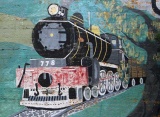 21 December 1971Full steam ahead for Kingston Flyer
21 December 1971Full steam ahead for Kingston FlyerA few months after the last steam locomotives had been withdrawn from this country's scheduled rail operations, New Zealand Railways launched a new tourist-oriented steam passenger venture in the South Island. Read more...
-
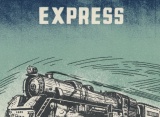 25 October 1971End of the line for steam railways
25 October 1971End of the line for steam railwaysThe Christchurch–Dunedin overnight express, headed by a JA-class locomotive, ran the last scheduled steam-hauled service on New Zealand Railways (NZR), bringing to an end 108 years of regular steam rail operations in this country. Read more...
-
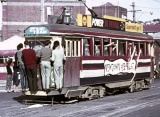 2 May 1964New Zealand's last electric tram trip
2 May 1964New Zealand's last electric tram tripTram no. 252, displaying the message ‘end of the line’ and driven by Wellington Mayor Frank Kitts, travelled from Thorndon to Newtown zoo. Large crowds lined the streets to witness the end of electric trams in New Zealand. Read more...
-
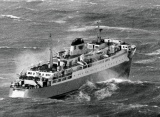 11 August 1962Picton ferry Aramoana enters service
11 August 1962Picton ferry Aramoana enters serviceFew ships have had as much impact on New Zealand history as the Aramoana, the country’s first roll-on roll-off ferry, which entered service between Wellington and Picton in 1962. Read more...
-
 30 May 1959Auckland harbour bridge opens
30 May 1959Auckland harbour bridge opensNew Zealand’s best-known bridge opened after four years of construction. The need for better transport links between Auckland city and the North Shore had long been the subject of inquiry and agitation. Read more...
-
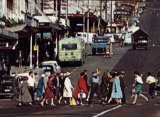 21 August 1958Auckland pedestrians begin 'Barnes Dance'
21 August 1958Auckland pedestrians begin 'Barnes Dance'Auckland became the first New Zealand city to introduce the ‘Barnes Dance’ system, which stopped all traffic at intersections, allowing pedestrians to cross in any direction at the same time. Read more...
-
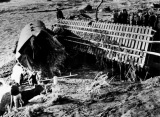 24 December 1953Tangiwai railway disaster
24 December 1953Tangiwai railway disasterThe worst railway disaster in New Zealand’s history occurred on Christmas Eve 1953, when the Wellington–Auckland night express plunged into the flooded Whangaehu River, just west of Tangiwai in the central North Island. Read more...
-
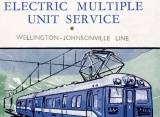 2 July 1938Electric trains come to Wellington
2 July 1938Electric trains come to WellingtonOn 2 July 1938, Minister of Railways Dan Sullivan and Wellington Mayor Thomas Hislop officially opened the electrified rail line between central Wellington and the northern suburb of Johnsonville. Read more...
-
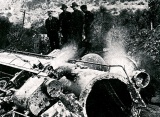 6 July 1923Main Trunk Line express train disaster
6 July 1923Main Trunk Line express train disasterThe Auckland−Wellington express ploughed into a huge slip that had slumped across the tracks at Ōngarue, north of Taumarunui in King Country. Read more...
-
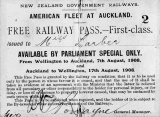 7 August 1908First train runs length of main trunk line
7 August 1908First train runs length of main trunk lineThe 'Parliament Special' travelled over a makeshift track in the central section of the still-unfinished main trunk line. It carried MPs north to greet the American navy's 'Great White Fleet'. Read more...
-
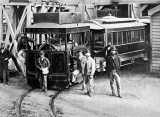 24 August 1878Wellington steam-tram service opened
24 August 1878Wellington steam-tram service openedThe governor, the Marquess of Normanby, formally opened the new service, which was said to be the first in the southern hemisphere. Read more...
-
 11 October 1861First Cobb & Co. coach service runs to Otago goldfields
11 October 1861First Cobb & Co. coach service runs to Otago goldfieldsIn its first venture from Dunedin to Gabriels Gully, near Lawrence, Cobb & Co. reduced the time for the trip from two days to nine hours. Read more...
Articles
Parliament's people

Today there are usually between 120 and 123 MPs in New Zealand's Parliament, which is a far cry from the 37 who met for the first time in Auckland in 1854.
-
Page 4 – Pay and travel
One of the early issues parliamentarians discussed was pay for MPs, and one of the biggest difficulties MPs faced in the early years was travelling to Parliament.
The North Island main trunk line
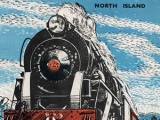
All aboard! The North Island main trunk railway was 100 years old in 2008. Take a trip back in time to explore the epic story of its construction, the heyday of the steam passenger train and the place of the iconic railway refreshment room in New Zealand life.
-
Page 3 – Rise and fall
A history of the North Island railway main trunk line since the first through train left Wellington on 7 August 1908
-
Page 4 – Travelling by train
For most second-class travellers, travelling the main trunk meant a long, sleepless journey on hard-backed seats, struggling to find 'elusive comfort with the NZR pillow'.
-
Page 5 – Refreshments
Refreshments are an essential and often talked about part of any train journey.
New Zealand disasters timeline
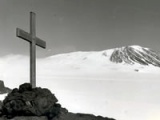
The disasters timeline and map give an overview of New Zealand's worst natural disasters, transport accidents, fires, mining accidents and other tragedies that have caused major loss of life.
- Page 1 - New Zealand disasters timelineThe disasters timeline and map give an overview of New Zealand's worst natural disasters, transport accidents, fires, mining accidents and other tragedies that have caused major
Railway stations
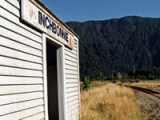
Before most people had cars or telephones, let alone television and the Internet, the railway provided many communities with their main connection to the outside world.
- Page 1 - Railway stationsBefore most people had cars or telephones, let alone television and the Internet, the railway provided many communities with their main connection to the outside
Cook Strait rail ferries

On a fine, calm day ‘Cruising on the Interislander’ can be like a luxury Mediterranean cruise. But on a bad day Cook Strait can be one of the world's roughest stretches of water: seasickness, dodgy food and wildcat strikes have all been part of the colourful Cook Strait ferry story.
-
Page 2 – 'The floating bridge'
Before 1962 rail struggled to compete with ships for inter-island business, but the road/rail ferries changed that.
-
Page 3 – 'An array of awful pies'
In the 1960s, the ferries' food and services fell short of the glossy ads, but now they are more upmarket.
-
Page 4 – Rough crossings
Crossing Cook Strait is often idyllic, but it can be one of the world’s roughest stretches of water as it's part of the westerly wind belt known as the Roaring Forties
-
Page 5 – Branding the Cook Strait ferries
From 'puke' green to funnells sprouting ferns, the ferries' branding and appearance have had many changes.
-
Page 6 – Strikes and strandings
Cook Strait ferries were vital to the flow of freight and passengers between the North and South islands, and interruptions because of bad weather, mechanical problems
-
Page 7 – Fast ferries on Cook Strait
The old fable about the tortoise and the hare was replayed on Cook Strait as fast ferries offered travellers a quick dash across the ditch.
Tangiwai disaster
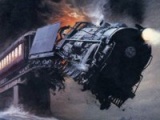
New Zealand's worst railway disaster occurred 60 years ago on Christmas Eve 1953, when the Wellington–Auckland night express plunged into the swollen Whangaehu River near Tangiwai. Of the 285 people on board, 151 were killed. The tragedy stunned the world and left a nation in mourning.
- Page 1 - Tangiwai railway disasterNew Zealand's worst railway disaster occurred 60 years ago on Christmas Eve 1953, when the Wellington–Auckland night express plunged into the swollen Whangaehu River near
Central Powers

Key statistics and facts about the forces of Austria-Hungary, Bulgaria, Germany and the Ottoman Empire during the First World War
- Page 1 - Central PowersKey statistics and facts about the forces of Austria-Hungary, Bulgaria, Germany and the Ottoman Empire during the First World
NZ's First World War horses
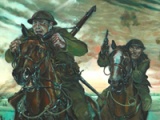
Between 1914 and 1916 the New Zealand government acquired more than 10,000 horses to equip the New Zealand Expeditionary Force. They served in German Samoa, Gallipoli, the Middle East and on the Western Front. Of those that survived the war, only four returned home.
-
Page 3 – Transporting horses from NZ
Nearly all of the 10,000 horses the government acquired for the New Zealand Expeditionary Force between 1914 and 1916 went overseas.
-
Page 5 – Egypt and Gallipoli
Some draught horses accompanied the divisional artillery and transport and supply units to Gallipoli in April 1915 to assist with their work. But the conditions proved
The Merchant Navy
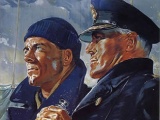
3 September is Merchant Navy Day, which was first officially commemorated in New Zealand in 2010. The date marks the sinking of the first Allied merchant ship in 1939, just hours after the Second World War began. This is the story of the 'fourth service' at war.
- Page 2 - The longest lifelineAn island nation half a world away from its main trading partner, New Zealand in the mid-20th century was overwhelmingly dependent on sea transport for its prosperity and
Life in the 20th century
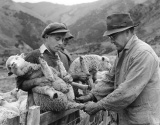
Exploration of everyday life in New Zealand from 1900 to the mid-1980s
- Page 4 - Bridging the gapThe transformation of space through new communication and transport systems was a preoccupation in nineteenth-century New Zealand; twentieth-century society was no less intent on
Assisted immigration, 1947-75
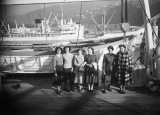
New Zealand is a country of immigrants. Wave after wave of peoples have settled here: Polynesian, British, European, Asian.
- Page 4 - The voyage outThe Captain Cook, along with the Captain Hobson, brought assisted immigrants to New Zealand via the Panama Canal from
The Vogel era

In 1870, Colonial Treasurer Julius Vogel launched the most ambitious development programme in New Zealand’s history. The ‘Vogel era’ was a decisive moment in New Zealand’s 19th-century transformation from a Māori world to a Pākehā one.
- Page 2 - New Zealand in 1870Three decades after the signing of the Treaty of Waitangi, New Zealand’s two main islands were like two different
Lyttelton-Wellington ferries
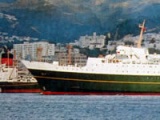
For more than 80 years the overnight Lyttelton ferry was a vital link in the country's transport network.
- Page 4 - Politicians and ferriesPoliticians used the ferries to travel between their electorates and Wellington, so they scrutinised the Union Steam Ship Company's management of the
Notes for My Successor
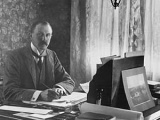
Until the late 1960s New Zealand's governors-general were British, mainly minor aristocrats, or admirals or generals.
- Page 7 - The governor-general on the moveHow the governors-general moved about the
Rail tourism
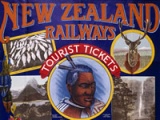
From the late 19th century the expanding rail network opened up exciting leisure and tourism opportunities for ordinary New Zealand families. New Zealand Railways promoted rail holidays through bright, attractive posters and its own popular monthly magazine.
- Page 6 - Post-war changesAfter the peak years of the 1920s and late 1930s, tourist travel all but ceased during the Second World War.
Biographies
-
 Vogel, Julius
Vogel, Julius
Premier Julius Vogel's great plan was to borrow heavily to build infrastructure and to lure migrants. It was controversial, but the money and migrants stimulated the economy and created a viable consumer market for producers.
Read more...
Related keywords
- WW1
- horses
- france
- artillery
- railways
- temuka
- timaru
- public works
- shipping
- MPs
- ferries
- governor-general
- trains
- cars
- wellington city
- queen elizabeth
- britannia
- western front
- pioneer battalion
- passchendaele offensive
- maori in war
- tourism
- exploration
- pre-1840 contact
- gallipoli campaign
- anzac cove
- famous firsts
- historic places
- cook strait
- cycling
- strikes
- advertising
- parliament
- trams
- kingston
- WW2
- merchant navy
- economy
- egypt
- new zealand mounted rifles
- legislative council
- denis blundell
- scenery
- buller
- le quesnoy liberation
- state housing
- glen innes
- food
- overlander
- refreshments
- railway stations
- taumarunui
- picton
- armistice
- masterton
- parades
- goldfields
- otago region
- cartoon
- william cargill
- lord ranfurly
- frank kitts
- thorndon
- 1960s
- johnsonville
- dan sullivan
- thomas hislop
- lyttelton
- disasters
- ongarue
- north african campaign
- camel corps
- palestine campaign
- merchant marine
- roading
- auckland city
- auckland harbour board
- great white fleet
- children
- royalty
- governor
- lord plunket
- cape helles
- seddonville
- coal mining
- julius vogel
- gold
- new zealand wars
- provinces
- whanganui city
- whanganui river
- samoa
- police
- mau movement
- clothing
- antarctica
- huskies
- bridges
- radio broadcasts
- pacific war
- 1970s
- women in politics
- Maori MPs
- bellamys
- immigration
- assisted immigration
- immigrants
- british
- tangiwai disaster
- tangiwai
- premiers
- newspapers
- maori land
- floods
- raurimu
- edmund hillary
- central powers
- austro-hungarian empire
- germany
- bulgaria
- ottoman empire
- air transport
- erebus disaster
- wahine disaster
- CEISMIC
- timeline
- hawkes bay earthquake
-
Main image: NZ artillery gun team
A New Zealand gun team on the move near Lumbres, northern France, May 1917.

